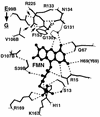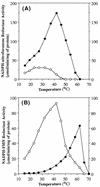Conversion of NfsA, the major Escherichia coli nitroreductase, to a flavin reductase with an activity similar to that of Frp, a flavin reductase in Vibrio harveyi, by a single amino acid substitution
- PMID: 9440535
- PMCID: PMC106901
- DOI: 10.1128/JB.180.2.422-425.1998
Conversion of NfsA, the major Escherichia coli nitroreductase, to a flavin reductase with an activity similar to that of Frp, a flavin reductase in Vibrio harveyi, by a single amino acid substitution
Abstract
NfsA is the major oxygen-insensitive nitroreductase of Escherichia coli, similar in amino acid sequence to Frp, a flavin reductase of Vibrio harveyi. Here, we show that a single amino acid substitution at position 99, which may destroy three hydrogen bonds in the putative active center, transforms NfsA from a nitroreductase into a flavin reductase that is as active as the authentic Frp and a tartrazine reductase that is 30-fold more active than wild-type NfsA.
Figures



Similar articles
-
Biochemical characterization of NfsA, the Escherichia coli major nitroreductase exhibiting a high amino acid sequence homology to Frp, a Vibrio harveyi flavin oxidoreductase.J Bacteriol. 1996 Aug;178(15):4508-14. doi: 10.1128/jb.178.15.4508-4514.1996. J Bacteriol. 1996. PMID: 8755878 Free PMC article.
-
Conversion of NfsB, a minor Escherichia coli nitroreductase, to a flavin reductase similar in biochemical properties to FRase I, the major flavin reductase in Vibrio fischeri, by a single amino acid substitution.J Bacteriol. 1996 Aug;178(15):4731-3. doi: 10.1128/jb.178.15.4731-4733.1996. J Bacteriol. 1996. PMID: 8755909 Free PMC article.
-
Identification of the gene encoding the major NAD(P)H-flavin oxidoreductase of the bioluminescent bacterium Vibrio fischeri ATCC 7744.J Bacteriol. 1994 Jun;176(12):3536-43. doi: 10.1128/jb.176.12.3536-3543.1994. J Bacteriol. 1994. PMID: 8206830 Free PMC article.
-
Reduced flavin: donor and acceptor enzymes and mechanisms of channeling.Antioxid Redox Signal. 2001 Oct;3(5):881-97. doi: 10.1089/15230860152665046. Antioxid Redox Signal. 2001. PMID: 11761334 Review.
-
Activity coupling and complex formation between bacterial luciferase and flavin reductases.Photochem Photobiol Sci. 2008 Feb;7(2):183-8. doi: 10.1039/b713462b. Epub 2007 Dec 20. Photochem Photobiol Sci. 2008. PMID: 18264585 Review.
Cited by
-
Unusual folded conformation of nicotinamide adenine dinucleotide bound to flavin reductase P.Protein Sci. 1999 Sep;8(9):1725-32. doi: 10.1110/ps.8.9.1725. Protein Sci. 1999. PMID: 10493573 Free PMC article.
-
Biological degradation of 2,4,6-trinitrotoluene.Microbiol Mol Biol Rev. 2001 Sep;65(3):335-52, table of contents. doi: 10.1128/MMBR.65.3.335-352.2001. Microbiol Mol Biol Rev. 2001. PMID: 11527999 Free PMC article. Review.
-
Cloning and sequence analysis of two Pseudomonas flavoprotein xenobiotic reductases.J Bacteriol. 1999 Oct;181(20):6254-63. doi: 10.1128/JB.181.20.6254-6263.1999. J Bacteriol. 1999. PMID: 10515912 Free PMC article.
-
Single- and Two-Electron Reduction of Nitroaromatic Compounds by Flavoenzymes: Mechanisms and Implications for Cytotoxicity.Int J Mol Sci. 2021 Aug 8;22(16):8534. doi: 10.3390/ijms22168534. Int J Mol Sci. 2021. PMID: 34445240 Free PMC article. Review.
-
Fre Is the Major Flavin Reductase Supporting Bioluminescence from Vibrio harveyi Luciferase in Escherichia coli.J Biol Chem. 2009 Mar 27;284(13):8322-8. doi: 10.1074/jbc.M808977200. Epub 2009 Jan 12. J Biol Chem. 2009. PMID: 19139094 Free PMC article.
References
-
- Bryant D W, McCalla D R, Leeksma M, Laneuville P. Type I nitroreductases of Escherichia coli. Can J Microbiol. 1981;27:81–86. - PubMed
-
- Duane W, Hastings J W. Flavin mononucleotide reductase of luminous bacteria. Mol Cell Biochem. 1975;6:53–64. - PubMed
-
- Jablonski E, DeLuca M. Purification and properties of the NADH and NADPH specific FMN oxidoreductases from Beneckea harveyi. Biochemistry. 1977;16:2932–2936. - PubMed
-
- Koike, H., H. Sasaki, T. Kobori, S. Zenno, K. Saigo, M. E. P. Murphy, E. T. Adman, and M. Tanokura. Unpublished data. - PubMed
-
- Laemmli U K. Cleavage of structural proteins during the assembly of the head of bacteriophage T4. Nature. 1970;227:680–685. - PubMed
Publication types
MeSH terms
Substances
LinkOut - more resources
Full Text Sources
Molecular Biology Databases
Miscellaneous

